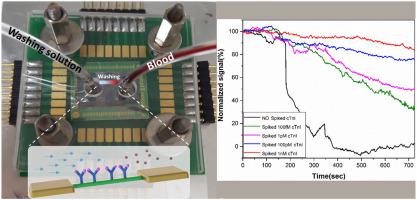Biosensors and Bioelectronics ( IF 10.7 ) Pub Date : 2020-09-28 , DOI: 10.1016/j.bios.2020.112658 Marina Zverzhinetsky , Vadim Krivitsky , Fernando Patolsky

|
A wide range of fields, starting from basic research in life sciences and up to medical applications, are highly interested in the investigation and detection of biomarkers in all their forms, including proteins. However, direct analytical detection of specific protein biomarkers from a physiological biosample is still extremely challenging due to the abundant variety and amount of its components.
In this work, we apply the chemically-controlled antigen-dissociation detection approach on silicon nanowires-based field-effect transistor arrays, by creating a suitable ‘chemical environment’ which enabled the clear-cut splitting of the dissociation regime window into two sub-regimes, thus allowing the complete washing of the nonspecifically adsorbed salts and biomolecules, while significantly delaying the dissociation of specific surface-bounded antigen-antibody pairs. This was accomplished by the addition of the water-miscible organic reagent ethylene glycol, which radically alters the properties of the aqueous solvent, by means of dramatically reducing its interactions with the particular protein antigen, and thus allowing for the increase in the antigen-antibody interaction strength. This in turn, deeply reduces the solubility of the surface-bound protein molecules and increases their interaction with the specific receptor antibody units, which brings to a substantial delay in the antibody-antigen dissociation behavior. This phenomenon allows the clear-cut splitting of the dissociation regime window and the quantitative and accurate analysis of proteins in physiological samples. We demonstrated the direct and quantitative detection of protein biomarkers, down to concentrations in the fM range, from unprocessed whole blood minuscule samples of only a few microliters. This work is the first demonstration on the chemically-controlled dissociation kinetics of antibody-antigen pairs by the use of water-miscible organic solvent mixtures, and its application in the direct ultrasensitive detection of protein biomarkers from whole blood samples.
中文翻译:

通过从纳米传感器阵列化学延迟解离的抗原抗体直接进行全血分析
从生命科学的基础研究到医学应用,广泛的领域对包括蛋白质在内的所有形式的生物标志物的研究和检测都非常感兴趣。然而,由于其成分的多样性和数量丰富,从生理生物样品中直接分析检测特定蛋白质生物标志物仍然极具挑战性。
在这项工作中,我们通过创建合适的“化学环境”,将解离机制窗口清晰分为两个子区域,将化学控制的抗原解离检测方法应用于基于硅纳米线的场效应晶体管阵列。因此,允许完全洗涤非特异性吸附的盐和生物分子,同时显着延迟特异性表面结合的抗原-抗体对的解离。这是通过添加与水混溶的有机试剂乙二醇来实现的,该试剂通过显着降低其与特定蛋白抗原的相互作用,从而从根本上改变了水性溶剂的特性,从而使抗原抗体的增加互动强度。反过来,大大降低了表面结合的蛋白分子的溶解度,并增加了它们与特定受体抗体单元的相互作用,从而大大延迟了抗体-抗原的解离行为。这种现象可以使解离机制窗口得到清晰的分割,并可以对生理样品中的蛋白质进行定量和准确的分析。我们展示了从未经处理的仅几微升的全血微小样品,可以直接定量检测低至fM范围内浓度的蛋白质生物标志物。这项工作是通过与水混溶的有机溶剂混合物对抗体-抗原对进行化学控制的解离动力学的首次演示,并将其应用于从全血样品中直接超灵敏检测蛋白质生物标志物。









































 京公网安备 11010802027423号
京公网安备 11010802027423号